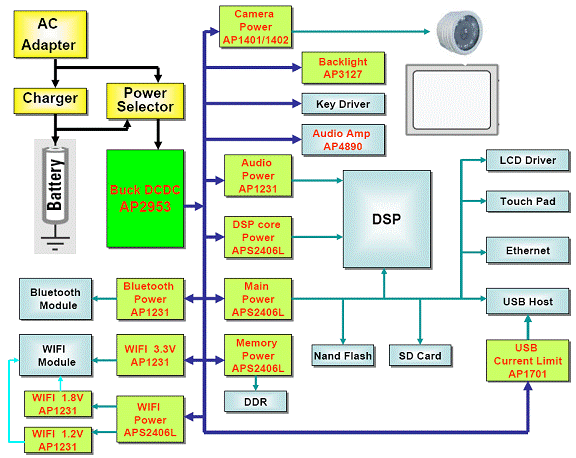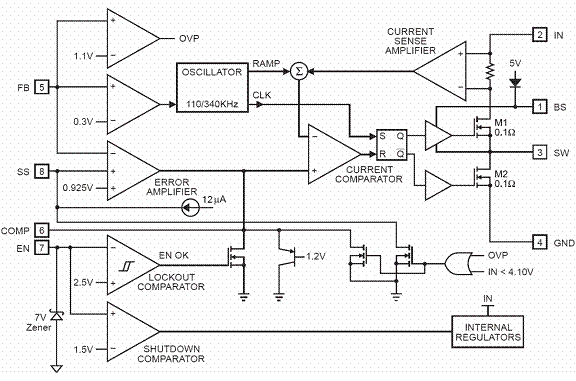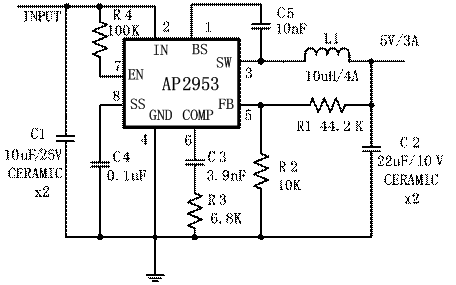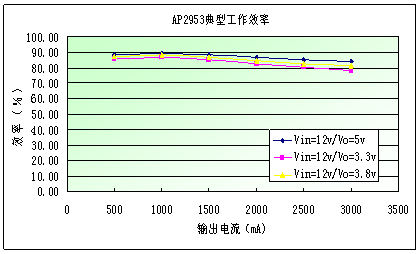Abstract: This article mainly introduces the application of high voltage and high power step-down DCDC chip AP2953 on ARM-based netbooks, as well as the structural characteristics, application design and application characteristics of AP2953.
This article refers to the address: http://
With the increase and popularity of network speeds, netbooks with low price and long battery life are increasingly favored by consumers. The ARM-based netbook has attracted the attention of many manufacturers and consumers due to its small size, light weight, low cost, low power consumption, long-lasting endurance, and simple production and maintenance. Freescale, Texas Instruments, TI, Anyka, Samsung and other companies based on ARM architecture gradually occupy a certain market. ARM architecture netbooks are usually powered by two or three lithium batteries, converted to 5V by high-efficiency step-down DCDC, and then converted to 3.3V, 2.5V, 1.8V, 1.2V and other voltages to supply various parts of the system. The ARM architecture netbook power supply structure is as follows:

Figure 1: The netbook power supply structure of the ARM architecture.
Highlighting the long-lasting endurance advantages of netbooks, in addition to the need for a suitable organizational structure, each voltage rail path and device selection is also an important part. In this application scheme, the external adapter voltage or battery pack voltage is efficiently converted into the system 5V main voltage by the high-voltage high-power DCDC-AP2953, and then converted by the high-efficiency low-power DCDC-APS2406L and the high-precision low-noise LDO-AP1231. The voltage applied to each part of the system or directly supplies power to the relevant 5V module to improve the overall conversion efficiency of the power supply.
AP2953 is a high-efficiency high-voltage and high-power synchronous buck conversion chip designed by Wuxi Xinpeng Microelectronics Co., Ltd. using BCD technology developed independently for portable mobile computing and portable mobile video and communication equipment. The input operating voltage is wide from 4.75V to 23V, and the output voltage is 0.925V adjustable to 20V. The continuous load current output of 3A ensures stable operation under all conditions of the system. Its efficiency is as high as 95%, meeting the increasing energy and long-term requirements of each system. The internal oscillation frequency is 340KHz to ensure minimal EMI interference to other parts of the system. The chip also features soft start (time adjustable) and cycle-by-cycle overcurrent protection, short circuit protection and over temperature protection. The internal structure block diagram of AP2953 is as follows:

Figure 2: Block diagram of the internal structure of AP2953.
Working principle: AP2953 is a current-mode synchronous rectification step-down DCDC converter with two MOS tubes. The output voltage is divided by an external resistor and amplified by an error amplifier, and then compared with the internally detected upper tube peak current. The result determines the duty cycle of the upper tube conduction time, and the duty cycle changes control the output voltage change. Thereby the negative feedback control is completed.
Soft start process: When the power is turned on, the feedback voltage will start below 0.1V, and the system enters the 110KHz working mode. The internal current source charges the soft-start capacitor. When the SS pin voltage reaches 0.925V, the soft-start ends.
Overcurrent protection and short circuit protection: The AP2953 monitors the upper and lower tube currents during each cycle. When the output is shorted to ground, the voltage sampled by the upper current limiting resistor reaches the set current limit point, the chip operating frequency becomes 110KHz, the COMP terminal is clamped, and the chip operates in the minimum duty cycle mode.
Typical application circuit of AP2953:

Figure 3: Typical application circuit for the AP2953.
Typical working efficiency of AP2953:

Figure 4: Typical operating efficiency of the AP2953.
Networking Keystone Jacks.China Cat5e Coupler Jack,Keystone Jack Short Body manufacturer, choose the high quality Cat5e Jack Short,Keystone Jack Unshield, etc, included keystone jacks for CAT6A, CAT6, CAT5E, and CAT3
Keystone jacks are snap in modules used to mount low voltage electrical connectors into a keystone wall plate, patch panel, face plate or surface mount box.
Our Keystone Jacks are available in 10 different colors for easy color-coded installations.
RJ45 port editing
1. Origin:
2. The name RJ stands for the registered jack and is the USOC (universal service ordering codes) code of bell system. USOC is a series of registered sockets and their wiring mode, which are developed by bell system to connect the user's equipment to the public network. FCC regulations control the application of this purpose. The FCC (Federal Communications Commission) issued a document on behalf of the U.S. government to specify RJ11.
3. RJ11 is the common name of the connector developed by Western Electric Co. Its shape is defined as a 6-pin connecting device. Originally called wexw, where x means "active", contact or needle. For example, we6w has all six contacts, numbered from 1 to 6. The we4w interface only uses four pins, the outermost two contacts (1 and 6) are not used, and we2w only uses the middle two pins. For RJ11, the information source is contradictory. It can be a 2 or 4-core 6-pin connector. What's more confusing is that RJ11 is not only used to represent the 6-pin connector, it also refers to the 4-pin version.
4. RJ45 and RJ11: different standards, different sizes
5. Due to the different sizes of the two (RJ11 is 4 or 6-pin, RJ45 is an 8-pin connection device), it is obvious that the RJ45 plug cannot be inserted into the RJ11 socket. However, it is physically feasible (RJ11 plug is smaller than RJ45 jack), which makes people think that they should or can work together. It's not. It is strongly recommended not to use RJ11 plug for RJ45 socket.
â’ because RJ11 is not internationally standardized, its size, insertion force, insertion angle, etc. are not in accordance with the international standard connector design requirements, so interoperability cannot be guaranteed. They even cause damage to both. Since the RJ11 plug is smaller than the RJ45 socket, the plastic parts on both sides of the plug will damage the metal pin of the inserted socket.
RJ - 45 port is our most common port, it is our common twisted pair Ethernet port
Because twisted pair is mainly used as transmission medium in Fast Ethernet, RJ-45 port can be divided into 10Base-T network RJ-45 port and 100base TX network RJ-45 port.
Among them, the RJ-45 port of 10Base-T network is usually identified as "eth" in the router, while the RJ-45 port of 100base TX network is usually marked as "10 / 100btx". This is mainly due to the fact that most products of Fast Ethernet router still adopt 10 / 100Mbps bandwidth adaptive.
The left figure shows the RJ-45 port of 10Base-T network, while the right figure shows the RJ-45 port of 10 / 100base-tx network. In fact, the two RJ-45 ports are exactly the same in terms of the port itself, but the corresponding network circuit structure in the ports is different, so they can not be connected casually.
Definition of RJ45 interface pin signal
Ethernet 10 / 100Base-T interface:
1 TX + tranceive data +
2 TX - tranceive data -
3 RX + receive data +
4 N / C not connected
5 N / C not connected
6 RX - receive data
7 n / C not connected
8 N / C not connected
Ethernet 100base-t4 interface:
1 TX_ D1 + tranceive data +
2 TX_ D1 - tranceive data
3 RX_ D2 + receive data +
4 BI_ D3 + bi directional data +
5 BI_ D3 bi directional data
6 RX_ D2 - receive data
7 BI_ D4 + bi directional data +
8 BI_ D4 bi directional data
Note: RJ45 interface adopts differential transmission mode, TX + and TX - are a pair of twisted pair, which can reduce interference when twisted together.
Cat5e Coupler Jack,Keystone Jack Short Body,Cat5e Jack Short,Keystone Jack Unshield
ShenZhen Antenk Electronics Co,Ltd , https://www.pcbsocket.com
